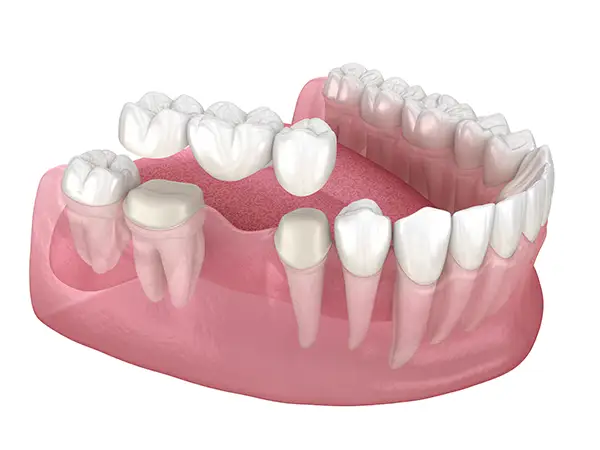Dental Bridge A dental bridge is a common way to replace missing teeth, and with the help of our experts at Avery Dental Center, you can find out if it is right for you. There are three types of bridges: A dental bridge is a common way to replace missing teeth, and with the help of our experts at Avery Dental Center, you can find out if it is right for you. There are three types of bridges:Traditional BridgeTraditional bridges are the commonest type. They are made from ceramic or porcelain fused to metal. They are attached to crowned teeth (or implants) on each side of the missing tooth with a pontic (false tooth) in between to fill the gap. Bridges can also be used to fill the gap created by several missing teeth. Cantilever BridgeThese are used when there is only a tooth on one side of the missing tooth. However, they are not as popular as they were these days. Maryland BridgeAlso known as a resin-bonded bridge, they have porcelain or metal wings on one side of the bridge. This is different from the others because rather than crowns they are bonded to the teeth. Am I A Suitable Candidate For a Bridge?If you have a tooth gap and want to fill it with the help of a dental bridge, your teeth on either side need to be healthy enough for this procedure. Restorations can only be placed if you have no signs of active gum disease, tooth decay, or any other oral health conditions. If you do, we will need to work on your other dental health issues before we can fit a bridge. What is the Procedure for a Dental Bridge?After a comprehensive exam and X-rays, the dentist will assess whether a dental bridge is a suitable restorative treatment for you. If we determine that a bridge is viable, the next steps are to prepare the teeth. We begin by shaping and filing down any healthy tooth on either side of the gap to create abutment teeth, which are then prepared for placement with local anesthesia. Abutments must be carefully shaped so they can provide stable anchors for the restorative crowns. Next, impressions of your mouth are taken to send directly to a laboratory where your bridge is tailor-made. In the meantime, you will be fitted with a temporary bridge. Once the teeth are prepared, impressions are made to make plaster cast models of your teeth. These are sent to a laboratory where a technician created your tailor-made bridge. The second appointment in the dental bridge procedure takes place as soon as your bridge is made and is ready for placement. Once again, local anesthetic will often be applied at this point for increased comfort. Before affixing the bridge, your temporary bridge is removed, and if necessary, the teeth cleaned. Dental cement is used to secure the new bridge to complete the procedure. Dental Bridges AftercareYou will be given instructions on how best to look after your dental bridge so that it will serve you well for many years. While they are strong, they are not indestructible, so if you have any bad habits, such as crunching ice or biting your nails, you may have to curb them to ensure the longevity of your prosthodontics. You should have regular appointments with us so we can monitor your oral health and maintain a twice-daily brushing and flossing routine to keep your mouth as healthy as possible. With good care, your dental bridge can last in excess of 10 years, and a great deal longer for many people. Schedule an appointment for a dental bridge at Avery Dental Center. Call us at (380) 257-1684. |